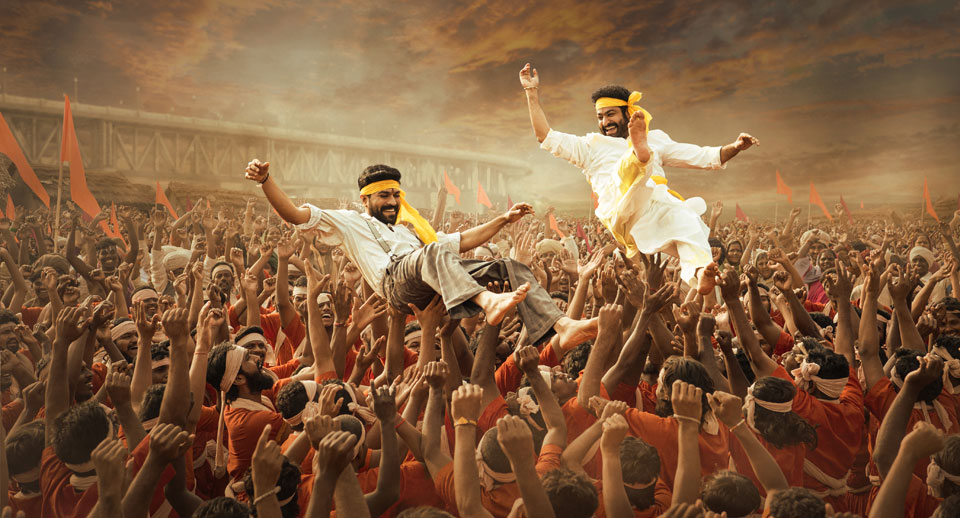
Like many viewers, you may be tired of the constant barrage of comic book hero movies about fictional beings saving the world in increasingly outlandish ways. Everyone loves a hero, but the formulaic mainstream DC and Marvel movies can begin to blend together. The film RRR brings the tale of two heroes—real-life Indian revolutionaries to the big screen and connects their struggle to the raw history of British colonialism, thus breathing new life into this subgenre of action films.
RRR is a movie with big action, compelling twists, and endearing characters. By embedding real history and struggle within this epic saga, it takes on an elevated flair that stays with the viewer long after the credits have rolled.
Directed by S.S. Rajamouli, who co-wrote the film with V. Vijayendra Prasad, RRR centers around two real-life Indian revolutionaries, Alluri Sitarama Raju and Komaram Bheem. The concept is interesting because the friendship in the film between the two figures is completely fictional. Rajamouli used coincidences of Raju and Bheem’s pasts to create this fictional bond. This gave the director the space to explore the undocumented period in the revolutionaries’ lives when they both chose to go into obscurity before they began to fight for their country.
It is this “what if” scenario that allows Rajamouli and Prasad to deal with themes and ideas that may have influenced the two Indian revolutionaries on their path towards becoming the important historic figures they eventually became.
When it comes to RRR, the obvious standout is the action and over-the-top stunts. Our main characters, Raju and Bheem, are nearly superhuman characters, achieving fantastical feats. It’s clear that Rajamouli wants the audience to fully embrace the larger-than-life potential of these two young freedom fighters. There will be moments involving tigers, motorcycles, and explosions that will surely feel outlandish, but it is in this hyper-reality that we’re able to embrace the metaphorical weight of who these characters were in real life—and the insurmountable odds they were up against in battling British colonialism. So, if you’re expecting a more down-to-earth fictional drama, this may not be your cup of tea.
N.T. Rama Rao Jr. and Ram Charan, who portray Raju and Bheem respectively, have great chemistry as two unlikely friends both on their own individual missions of rebellion. Viewers will understand both of their plights and root for their wins against the main villain of our story—the British Raj.
Unlike comic book hero-based action films, there is no singular monstrous villain with cartoonish wants for world domination. RRR uses the all-too-real brutality of the British empire as the force of evil in this tale. The British Raj was the period when London ruled the Indian subcontinent between 1858 and 1947. The racism and oppression of the British Raj is on full display in the film, giving a raw glimpse of what our heroes were up against during their lifetimes. And while the film is focused on our male main characters, there are a few women who play pivotal roles in the movie as well.
With all the great things going for the film, there are a few elements that may turn viewers away.
This movie is long. It goes on for three hours and seven minutes. Now, in a world where Marvel and DC films are clocking in at close to three hours, this may not seem like much for many. But it may be a deal-breaker for those who want stories in a two-hours-or-less format. Could the movie afford to shave off some minutes? Of course. There are a few scenes that feel repetitive, and some (awesome) action scenes that go on longer than they probably need to. But if the viewer fully embraces the world of this epic saga, they may forgive director Rajamouli for his indulgence.

Another element that might not gel well with audiences is that RRR can’t really be contained into one specific genre. Yes, it is an action film. The drama is heavy at times dealing with themes of racism, oppression, and violence. Then again, there are many scenes that give way to laughter that aren’t just comedy relief. There is also some really great singing by a number of characters and Bollywood-style dance scenes. It has a lot of everything in it. Once again, while many will enjoy the ride, some may want the film to pick a specific lane.
Yet, the relevancy of RRR cannot be denied. At a time when there are those who seek to burn books and stifle truthful education, a fun film that may peak the interests of viewers to explore revolutionary history is a great thing.
Alluri Sitarama Raju was an Indian revolutionary, who waged an armed campaign against the British colonial rule in India. He was one of the major leaders of the Rampa Rebellion of 1922. He helped to lead the combined forces of Adivasis (Indian tribal people), farmers, and other sympathizers to the cause, engaging in guerilla campaigns against the British. He was given the nickname “Manyam Veerudu” (translated into Hero of the Jungle) by villagers.
Komaram Bheem was a revolutionary leader in Hyderabad State of British India from the Gond tribes. He and other Gond leaders led a rebellion against the feudal Nizams of Hyderabad in the 1930s. Bheem decided to engage in armed revolution and formed associations with the Communist Party of India. Together, they mobilized the Adivasi population at Jodeghat, eventually forming a council of tribal leaders from the 12 traditional districts. The council decided to form a guerilla army to protect their lands. Bheem also proposed they declare themselves an independent Gond kingdom. His actions and leadership are seen as contributing to the culmination of the Telangana Rebellion of 1946.
Bheem has been deified in Gond culture and is credited for coining the slogan “Jal, Jangal, Zameen,” which translates into “Water, Forest, Land,” and is said to symbolize a sentiment against encroachment and exploitation.
These types of heroes are not the ones we hear about every day, or in many of the approved textbooks in schools across the country—or around the world. RRR places these figures center stage in a way that will most likely appeal to modern-day audiences. It’s a great adventure, and by the end of it, viewers may be inclined to read more about the history behind the movie.
RRR is currently streaming on Netflix.












Comments